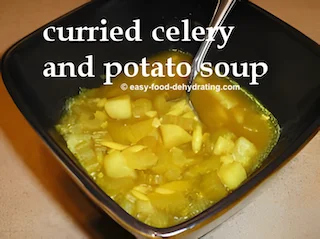What We Mean by “Dehydrate”
Here at Easy Food Dehydrating, “dehydrate” always means using an electric food dehydrator — the easy, reliable way to dry food at home.
- Home
- Dehydrating Vegetables: Step-by-Step Guides by Type
- How to Dehydrate Celery
Dehydrate Celery the Easy Way:
Preserve Fresh Flavor

Learning how to dehydrate celery is a simple way to stretch your grocery budget and reduce waste while keeping this crunchy veggie ready for soups, stews, and seasonings all year long.
✅ Quick Answer: How to dehydrate celery
Wash and slice celery into ⅛-inch pieces, arrange them on dehydrator trays, and dry at 125–135°F for 3–10 hours until brittle. Store in airtight jars or vacuum-sealed bags for up to 18 months.
Whether you’ve harvested celery from the garden or picked up a store-bought bunch, the dehydrating process is quick, easy, and locks in flavor for long-lasting storage.
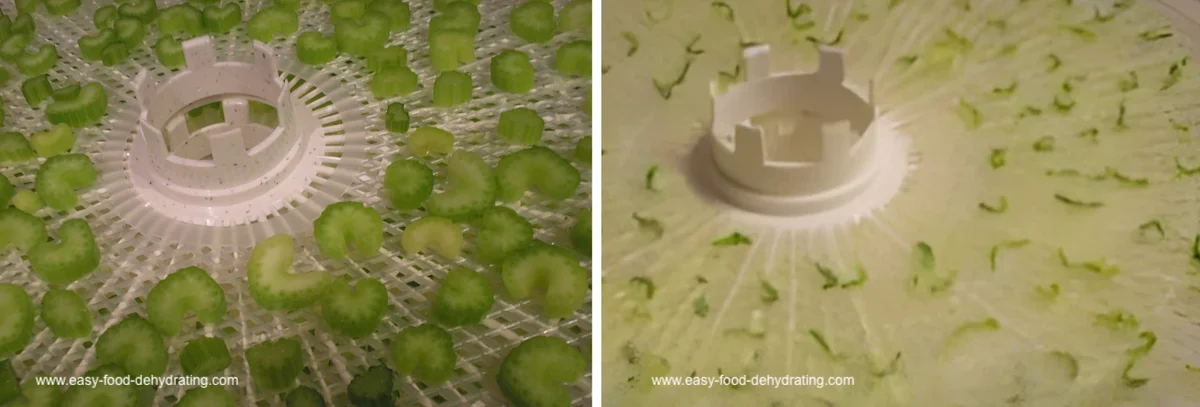
In this guide, I'll show you my favorite method for dehydrating celery slices and leaves—plus a few tasty ways to use them that go beyond soup!
🥦 What’s Inside Celery? Surprising Nutrition Facts
VITAMINS: Vitamin A, followed by Choline, Vitamin C, Niacin, and Pantothenic Acid. There are trace amounts of Riboflavin, Vitamin B6, Betaine, Folate, and Vitamin K.
MINERALS: Celery is rich in Potassium, Calcium, Magnesium, and Phosphorus. There are trace amounts of Iron, Selenium, Zinc, Manganese, and Fluoride.
Celery contains Omega-6 fatty acids.
Step-by-Step: The Fastest Way to Dehydrate Celery
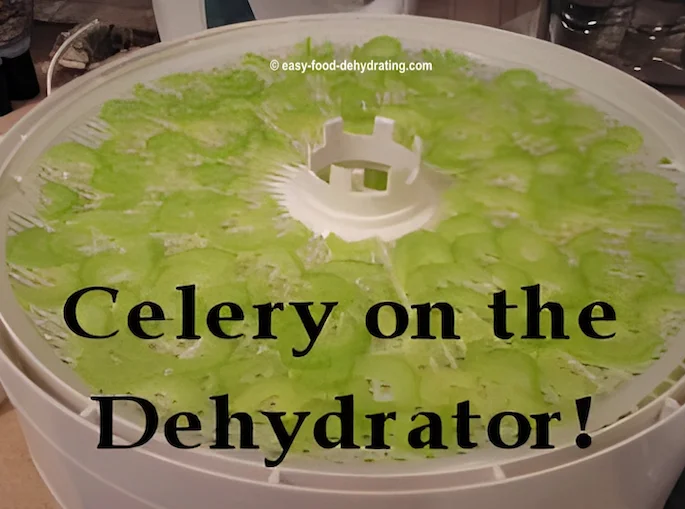
- Wash and slice fresh celery into 1/8" thick slices, a mandoline does a fine job of this—just watch your fingers, please!
- Arrange on your food dehydrator trays, making sure the celery slices don't touch.
- Turn on your food dehydrator and set the temperature between 125°F and 135°F (or per your food dehydrator's instructions).
💡 Tip: Outside the U.S.? Most dehydrating temps here are listed in Fahrenheit - use our quick converter to see the Celsius equivalent for your machine.
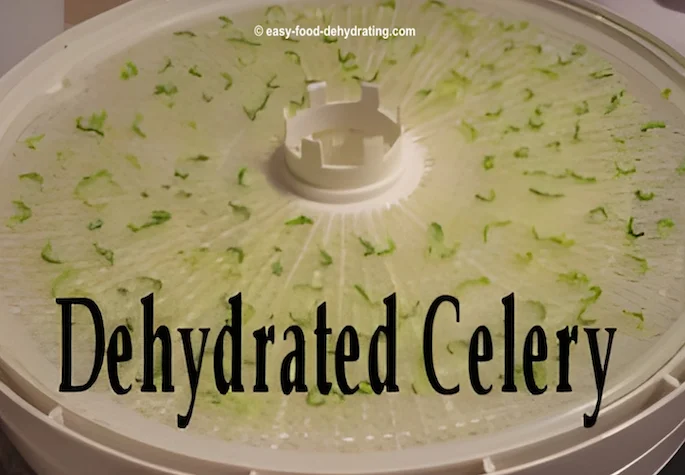
- Dehydrated celery will be leathery when fully dried. It reminds me of tiny seahorses for some strange reason ... :-)
- Drying time: between 3-10 hours.
- Please remember to rotate your trays for even drying.
Begin by Using a Good Sharp Knife by Cutluxe!
Check out this great chef's knife with a full tang that means the handle and blade "are one" so they can't come apart when we're slicin' and a dicin'.
I know these Cutluxe Chef knives may be a little expensive, but they do last pretty much a lifetime when you maintain their cutting edges.
As an Amazon Associate, I earn from qualifying purchases — this does not affect the price you pay. Read full disclosure.
Progressive International Mandoline Slicer
This is a fantastic mandoline from Amazon, but be very careful of the sharp blades – always use the slicing hand guard when appropriate!
It's a PL8 model and comes in white.
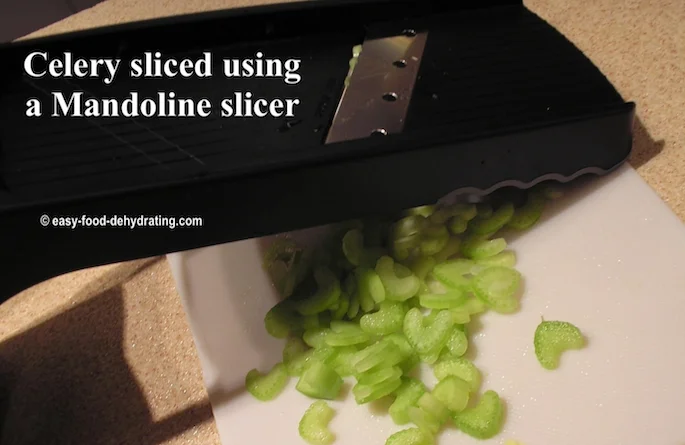
But my newest kitchen must-have is this:
SUPMAKIN Slicer + Dicer Mandoline ~ OnceForAll Brand
French fry cutter, vegetable chopper, vegetable slicer cutter, potato slicer, chopper for kitchen meal prep.
See my review of this multi-function mandoline that I just couldn't resist getting!
Delicious Soups You Can Make With Dehydrated Celery
Here are a couple of easy celery-based soups listed on our Recipes page for you to wrap your taste buds around: Celery and Potato Soup and a Curried version!
If you've got a great recipe to share too, please use the entry form on the bottom of our Recipes page to send it in so we can all benefit from your culinary creation! Thanks! :-
Don't forget to save the celery leaves!
They are superb when chopped up and added to soups. Also, don't discard the tiny part of the celery stalks.
These chop up so fast and easily and can be added to Tuna salad and Chicken Salad!
Dehydrated celery is fantastic re-hydrated—it plumps up really well and you can't tell the difference from fresh! Honest!
🧂 How to Make Flavor-Packed Celery Salt in Minutes
Celery salt is great for stews and soups too. You can easily make your own celery salt (add equal parts of salt and ground up celery powder) by using your grinder/coffee mill. Please - do a taste test as you go!
Have you ever tried celery with peanut butter? Sounds odd, I know, but it tastes delicious!
Want to Grow Celery? Easy Steps to Get Started
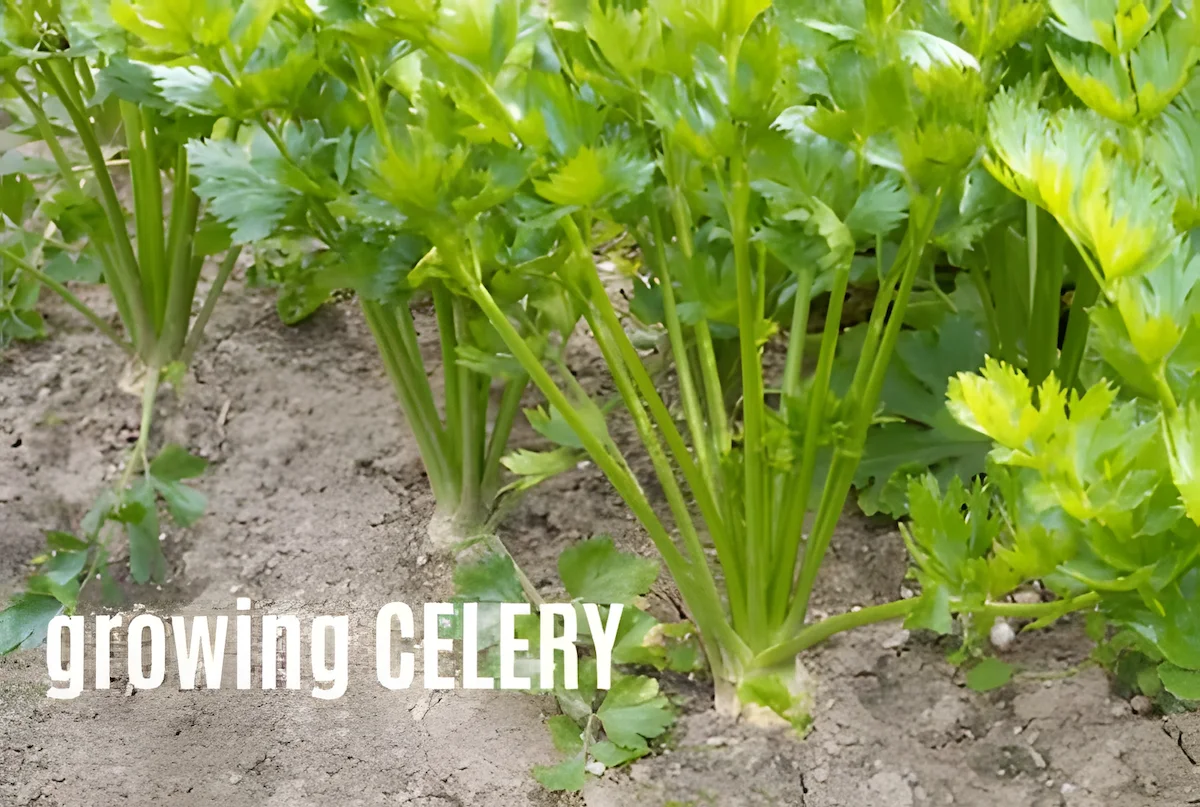
Celery is a cool-weather crop, so it is best to start seeds indoors in late winter or early spring.
Once the seedlings are big enough to handle, they can be transplanted outside.
Celery requires moist, well-drained soil and full sun to grow well. Watering celery regularly is important, as the plants will not tolerate drought conditions.
Celery is typically harvested in the fall after the leaves have started to turn yellow.
Best Places to Grow Celery in the U.S.
After you've learned how to dehydrate celery, you may be interested in learning how to grow celery in the United States. Here are key areas that are ideal.
The Northeast: The northeastern region of the United States has long been considered one of the best places to grow celery because of cooler temperatures and higher rainfall levels in this part of the country.
The Midwest: The Midwest is also a good place to grow celery. This region has a moderate climate, with neither too hot nor too cold temperatures. Rainfall levels are also fairly high in the Midwest, which is ideal for celery growing.
The West: The western United States is generally considered to be a less ideal place to grow celery because the climate is generally drier and hotter in this part of the country.
4 Celery Varieties Worth Dehydrating (and Growing)
There are several different types of celery that you can grow. Some of the most popular varieties include:
🌱 4 Delicious Celery Varieties You Can Dehydrate (or Grow!)
Celery isn’t just the pale green stalks from the supermarket. Here are four tasty types worth dehydrating—or planting in your garden:
Mild and earthy, grown for its big bulbous root. Excellent in soups, stews, and creamy purées.
Knobby root with a stronger, aromatic flavor. Shred for salads, use as a garnish, or enjoy raw and crisp.
The classic supermarket variety—crisp, mild, and versatile. Great raw, cooked, or dehydrated.
Striking red stalks with a slightly sweeter taste. Adds color to salads and dehydrates beautifully for soups.
FAQ: Dehydrating Celery — From Leaves to Oven Tips
Got questions about dehydrating celery? You’re not alone — here are our most popular answers, tips, and pro tricks:
Can you dehydrate celery leaves?
Can you dehydrate celery leaves?
Yes! Spread washed, dried leaves on dehydrator trays and dry at 115°F for 2–4 hours until crispy. Store in jars and crumble into soups, stews, and seasonings.
Can you dehydrate celery in the oven?
Can you dehydrate celery in the oven?
Yes, but keep temps low (145–190°F). Slice celery thin, place on parchment-lined trays, and bake with the door slightly open for 3–4 hours until brittle.
What can you use dehydrated celery for?
What can you use dehydrated celery for?
Add rehydrated pieces to soups, stews, and casseroles, grind into celery powder or salt, or mix into homemade seasoning blends.
How long does dehydrated celery last?
How long does dehydrated celery last?
Stored in airtight jars or food vacuum sealer bags in a cool, dark spot, it lasts 12–18 months. For maximum shelf life, vacuum-seal or store with oxygen absorbers and desiccant packets.
Now that you know how easy it is to dehydrate celery, you’ll always have this versatile veggie on hand for soups, casseroles, or even homemade celery salt.
And if you’re ready to try more flavor-packed ideas, grab your free 5 Dried Food Recipes You’ll Actually Love PDF below — featuring carrot soup, minestrone, split pea soup, spicy beef jerky, and even banana cinnamon rolls.
Get 5 Dried Food Recipes You'll Actually Love
Here's where you can get your copy of our all new
5 Dried Food Recipes (That Actually Taste Great)
They're my all-time favorite easy dried food meals!
Get it here right now.
For Free!
Before You Go...
If you enjoyed this page, tap the ❤️ in the lower right-hand corner.
It saves this page to your Grow bookmarks so you can find it again later.
You’ll also see quick share buttons to copy the link, post to Facebook,
or save it straight to Pinterest.




